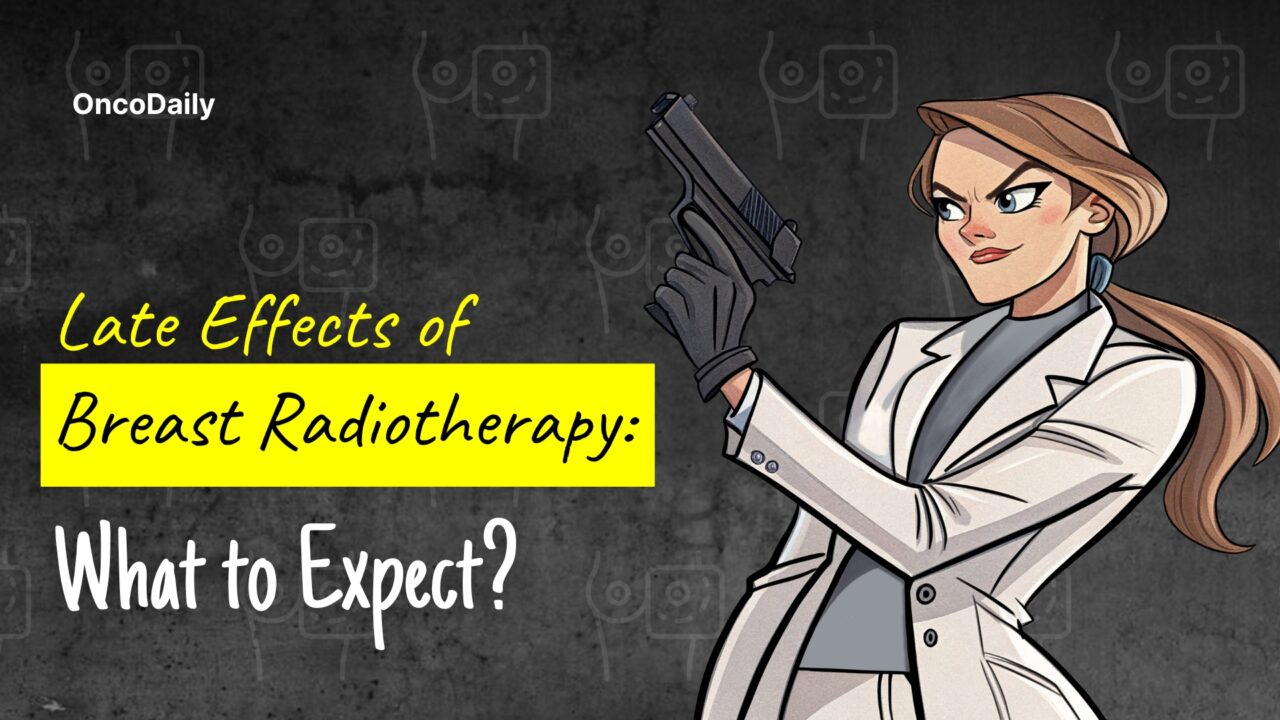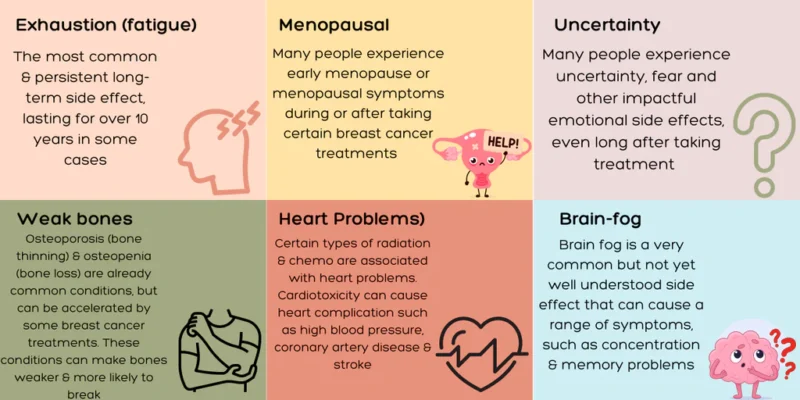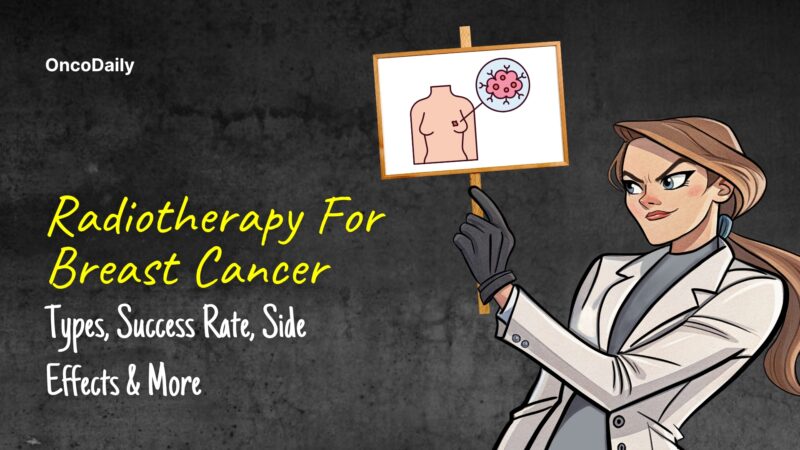
Understanding the Late Effects of Breast Radiotherapy: What to Expect
Late effects of breast radiotherapy are side effects that develop months or years after treatment, as radiation can cause changes in tissues and organs. These effects include skin changes, lung inflammation (radiation pneumonitis), heart problems, and nerve damage (brachial plexopathy). Patients may experience breathlessness, chest pain, or tingling in the arms. Understanding these late effects of breast radiotherapy effects is crucial for long-term care, as proper follow-up with healthcare providers helps manage and address any issues that arise.
What Are the Late Effects of Breast Radiotherapy?
Late effects of breast radiotherapy can develop months or even years after treatment ends. These effects occur due to changes in the tissues and organs affected by radiation. For instance, lymphedema can cause swelling in the arm as a result of damage to the lymphatic system, while fibrosis leads to the treated area becoming firmer and smaller over time. The skin may also undergo changes, with visible spider veins or slight alterations in appearance.
Radiation pneumonitis is another potential late effect, with symptoms such as breathlessness, dry cough, and chest pain occurring two to three months post-treatment. This condition can be managed with steroids, and most patients fully recover. Additionally, patients who undergo radiation to the left breast may experience an increased risk of heart problems over time. However, modern techniques like breath-holding help minimize this risk. In rare cases, brachial plexopathy, which affects the nerves in the shoulder, arm, or hand, can result in burning or tingling sensations. Treatment options for this include physiotherapy, pain management, or surgery if necessary. These late effects highlight the importance of ongoing monitoring and care after late effects of breast radiotherapy.
Types of Late Effects of Breast Radiotherapy
Late effects of breast radiotherapy include physical, emotional, and mental challenges. Physically, patients may experience scarring, skin changes, and fibrosis, which can affect the breast’s appearance and feel. Emotionally, anxiety about recurrence and body image concerns are common, as treatment can alter both physical appearance and a patient’s sense of self. These effects underscore the importance of ongoing support for managing the long-term impacts of breast radiotherapy.
How Often Do These Effects Occur?
The occurrence of late effects from breast radiotherapy can vary widely. For example, heart problems are a known long-term risk for those who received left breast radiation therapy. Advances like breath-holding techniques help reduce this risk. Changes in skin appearance, such as firmness and small “spider veins,” are common. Lymphedema, one of the late effects of breast radiotherapy, affects a smaller percentage of patients. Emotional and mental health issues, such as anxiety or concerns about body image and recurrence, are also common but harder to quantify.
Batenburg et al. (2023) published a study in International Journal of Radiation Oncology Biology Physics on late effects of breast radiotherapy after hypofractionated treatment. Among 1613/2248 patients (72%) surveyed at a median of 38 months post-treatment, 16% (n = 265) reported late toxicity. Moderate/severe breast firmness (18%), chest wall pain (14%), and breast pain (10%) were noted. Functional impairments were more common in patients with late toxicity (13%-52%) than in those without (2%-26%). These patients also required more analgesics, physiotherapy, and lymphedema therapy.
Long-Term Side Effects of Breast Radiotherapy
Radiotherapy for breast cancer can lead to long-term side effects such as scarring, breast tissue changes, and skin discoloration. The breast may become firmer and slightly smaller, and visible “spider veins” may appear. Fibrosis, where the tissue becomes harder, can cause discomfort and changes in appearance. Skin discoloration, either darker or lighter, can also occur in treated areas.
To manage these effects, survivors can practice self-examinations, moisturize the skin, and consider physical therapy to reduce discomfort. Emotional well-being can be supported through counseling or support groups to help with body image and anxiety about recurrence. These steps can improve quality of life for whom who have the late effects of breast radiotherapy.
Chronic Breast Tissue Changes
Chronic breast tissue changes after radiotherapy, referred to as late effects of breast radiotherapy, can include fibrosis, which results in the breast tissue becoming firmer and harder. These changes may lead to alterations in the breast’s size and shape, occasionally making it slightly smaller. Some patients may also experience changes in sensation in the treated area.
For those impacted by these changes, reconstructive surgery and cosmetic procedures can help restore appearance and boost self-esteem. Options such as breast implants, fat grafting, or a combination of both can be considered to improve the aesthetic result. Consulting with a healthcare provider about these options can assist patients in making informed decisions, promoting comfort and confidence in their bodies.
Bartelink et al. (2007), published in the Journal of Clinical Oncology, reported that a 16 Gy boost dose in breast-conserving therapy increased severe fibrosis rates at 10 years from 1.6% (no boost) to 4.4% (P < .0001).
Skin Discoloration and Texture Changes
What Causes Delayed Radiotherapy Side Effects?
Late effects of breast radiotherapy occur due to the long-term biological effects of radiation on healthy tissues. While radiation is effective in targeting cancer cells during treatment, it can also damage surrounding normal tissues. Over time, the body’s healing process can lead to complications such as fibrosis, where tissue hardens due to scarring, or lymphedema, caused by impaired lymphatic drainage.
Radiation also affects blood vessels and connective tissue, leading to inflammation and scarring that may develop months or even years after treatment. For patients who receive radiation to the left breast, there is an increased risk of cardiovascular issues over time due to exposure of the heart to radiation. These effects are a result of changes at the cellular and molecular levels, with radiation continuing to influence tissue function long after the initial treatment ends, underscoring the importance of monitoring and managing the late effects of breast radiotherapy.
How Radiation Affects Tissue Over Time
Late effects of breast radiotherapy occur as a result of the way radiation damages cells and tissues over time. Radiation can cause direct cellular damage by disrupting DNA, leading to mutations and impairments in cell function. This damage doesn’t always show up immediately; in some cases, it takes months or even years for changes to become apparent. As the body works to repair the damage, the immune response plays a key role. Inflammation occurs as part of the healing process, but over time, this inflammation can lead to fibrosis, where tissue becomes stiff and scarred.
In addition to fibrosis, radiation affects the blood vessels and lymphatic system, which can result in chronic conditions like lymphedema. The body’s ability to regenerate damaged tissue decreases as time goes on, especially in areas exposed to high radiation doses. This ongoing process can prevent full recovery and contribute to the gradual development of long-term side effects.
Delayed Organ-Specific Effects
Late effects of breast radiotherapy can have a significant impact on specific organs, particularly the heart and lungs. For patients with left-sided breast cancer, radiation therapy poses an increased risk to the heart, particularly in the form of coronary artery disease. This is because radiation can cause long-term damage to blood vessels, increasing the risk of heart complications over time.
Additionally, radiation can affect the lungs, potentially leading to conditions like radiation pneumonitis. This condition causes inflammation and scarring of the lung tissue, leading to symptoms such as breathlessness, dry cough, and chest pain. The risk of developing such lung issues increases as time progresses after treatment. These delayed effects emphasize the importance of monitoring heart and lung health in patients who have undergone breast radiotherapy.
How Does Breast Radiotherapy Affect Heart Health?
Late effects of breast radiotherapy can have a significant impact on heart health, particularly for patients with left-sided breast cancer. Radiation therapy has been shown to increase the long-term risk of cardiovascular issues, especially coronary artery disease. This is because radiation can damage the heart’s blood vessels, raising the likelihood of heart-related complications as time progresses after treatment.
To mitigate this risk, modern techniques such as deep inspiration breath-hold (DIBH) have been developed. DIBH involves patients holding their breath during radiation therapy, which moves the heart out of the radiation field, reducing exposure and helping to protect the heart from damage. This advancement has proven effective in reducing the risk of heart disease in patients undergoing radiotherapy
Techniques to Protect the Heart
Late effects of breast radiotherapy can lead to heart health complications, but several techniques have been developed to minimize damage to the heart. One such method is deep inspiration breath-hold (DIBH). During DIBH, patients are instructed to hold their breath, which moves the heart away from the radiation field, significantly reducing its exposure to radiation. This technique has been shown to decrease the long-term cardiovascular risks associated with breast radiotherapy, especially for left-sided breast cancer patients.
In addition to DIBH, other advanced techniques, such as intensity-modulated radiation therapy (IMRT), are also employed to better target the tumor while sparing healthy tissues. These methods have been crucial in reducing the risk of heart disease and other cardiovascular issues, making radiotherapy safer and more effective for patients undergoing breast cancer treatment.
Heart-Related Side Effects
Late effects of breast radiotherapy can lead to heart-related issues, including coronary artery disease and heart valve problems. These conditions may develop over time due to the radiation’s impact on the heart tissue, particularly in patients who have undergone left-sided breast cancer treatment. The risk of coronary artery disease increases as radiation affects blood vessels, leading to atherosclerosis and other cardiovascular issues.
Long-term monitoring is crucial for early detection and management of heart-related side effects. Patients should have regular cardiovascular check-ups, including blood pressure monitoring and cholesterol assessments. Adopting a heart-healthy lifestyle, such as maintaining a balanced diet, exercising regularly, and avoiding smoking, can help reduce the risk of heart disease. Additionally, working closely with healthcare providers ensures prompt intervention if any heart-related symptoms arise.
Darby et al. (2013) published a study in NEJM on the late effects of breast radiotherapy and ischemic heart disease risk. Among 2168 women treated between 1958-2001 in Sweden and Denmark, 963 had major coronary events. The average heart dose was 4.9 Gy, with risk increasing by 7.4% per Gy (95% CI, 2.9-14.5; P<0.001). Risk began within 5 years post-radiotherapy and persisted for at least 20 years. Women with preexisting cardiac risk factors had greater absolute risk increases.

source: www.anaono.com
Chronic Fatigue and Insomnia After Treatment
Late effects of breast radiotherapy often include chronic fatigue and insomnia, which can significantly impact a patient’s quality of life long after treatment ends. Chronic fatigue may persist due to the cumulative effects of radiation on the body, while insomnia can stem from both physical discomfort and emotional distress following cancer treatment.
To combat these conditions, patients can benefit from regular physical activity, which helps to reduce fatigue and improve sleep. Maintaining proper sleep hygiene, such as keeping a consistent bedtime routine and creating a restful environment, can also be effective in managing insomnia. Additionally, cognitive behavioral therapy (CBT) has been shown to help address the underlying thoughts and behaviors that contribute to sleep difficulties, offering a valuable tool for improving both energy levels and sleep quality post-treatment.
Geinitz et al. (2004) published a study in Journal of Cancer Research and Clinical Oncology on the late effects of breast radiotherapy and fatigue. Among 38 patients assessed 2.5 years post-RT, fatigue levels remained similar to pre-RT values but were higher than immediate post-RT levels.
Managing Chronic Fatigue
Late effects of breast radiotherapy often include chronic fatigue, which can persist long after treatment ends. To manage this condition, incorporating gentle physical activity, such as walking or stretching, can help improve energy levels over time. Ensuring adequate rest and following a consistent sleep schedule also plays a crucial role in recovery.
If fatigue persists or worsens, seeking professional help is important to rule out underlying issues or receive targeted interventions. Healthcare providers can guide patients in managing chronic fatigue through tailored strategies, such as cognitive behavioral therapy (CBT) or other supportive treatments, to improve overall well-being.
Insomnia and Sleep Hygiene Tips
Late effects of breast radiotherapy may include insomnia, which can significantly impact overall quality of life. To improve sleep hygiene, it’s helpful to maintain a consistent sleep schedule, going to bed and waking up at the same time each day. Avoiding screens, such as phones or computers, before bed can also promote better sleep, as the blue light from devices can interfere with the body’s natural sleep cycle.
Creating a calming bedtime routine, such as reading or practicing relaxation techniques, can further help in winding down before sleep. These habits can support better rest and improve the management of insomnia following radiotherapy. These steps are particularly important in addressing the late effects of breast radiotherapy.
Can Radiotherapy Cause Secondary Cancers?
Late effects of breast radiotherapy may include an increased risk of secondary cancers due to radiation exposure. This risk, though small, can manifest as cancers that develop in areas exposed to radiation, such as sarcomas or lung cancers. The radiation used to treat breast cancer can affect surrounding tissues, leading to mutations in cells that may result in secondary malignancies over time.
While the overall risk of developing a secondary cancer remains low, it is important for patients to continue regular follow-up appointments to monitor for any signs of new cancers. Early detection and monitoring are crucial in managing these potential long-term effects of radiation therapy.
Types of Secondary Cancers
Late effects of breast radiotherapy can include the development of secondary cancers, although the risk remains low. Common types of secondary cancers associated with radiation exposure include contralateral breast cancer, esophageal cancer, lung cancer, hematologic malignancies and others that develop in areas of the body exposed to radiation during treatment.
The likelihood of developing secondary cancers varies, but it is important for patients to stay vigilant and adhere to regular screening recommendations. Preventive measures include following up with healthcare providers for early detection and maintaining a healthy lifestyle to reduce overall cancer risk. Regular check-ups are essential to monitor for any potential late effects of radiotherapy.
Stovall et al. (2008) published a study in International Journal of Radiation Oncology Biology Physics on the late effects of breast radiotherapy. Among patients treated with opposed tangential fields between 1985 and 1999, the average dose to the contralateral breast was 1.3 Gy. Younger women (<40) who received >1 Gy to the contralateral breast had a 2.5-fold increased risk of developing a second primary cancer, while no excess risk was observed in women over 40.
Monitoring and Prevention
FAQ
What are late effects of breast radiotherapy?
Late effects of breast radiotherapy are long-term side effects that develop months or years after treatment, including changes in skin, tissue, and emotional health.
How long after radiotherapy can late effects appear?
Late effects may appear months or even years after the completion of radiotherapy.
What are common physical late effects of breast radiotherapy?
Common physical effects include fibrosis, changes in breast size, skin discoloration, and lymphedema.
Can breast radiotherapy cause heart problems?
Yes, especially for left-sided breast cancer patients, as radiation can increase the risk of coronary artery disease and other heart-related issues.
How can I manage skin changes after breast radiotherapy?
Using moisturizing skincare products and avoiding direct sun exposure can help manage skin changes. Consult your doctor for additional treatments if needed.
What is lymphedema, and how is it related to radiotherapy?
Lymphedema is swelling caused by fluid buildup, often after radiotherapy. It can be managed with compression garments, manual lymphatic drainage, and physical therapy.
Can I prevent lymphedema after breast radiotherapy?
Maintaining a healthy weight, avoiding heavy lifting, and managing fluid buildup are preventive measures for lymphedema.
What emotional effects can I expect after breast radiotherapy?
Emotional effects like anxiety, depression, and body image issues are common, often resulting from physical changes and the psychological impact of cancer treatment.
How can I cope with body image changes after radiotherapy?
Reconstructive surgery, support groups, and therapy can help improve body image and self-esteem after radiotherapy.
Is it possible to reduce the risk of heart problems caused by radiotherapy?
Yes, advanced techniques like deep inspiration breath-hold (DIBH) can minimize heart exposure during treatment, reducing the risk of heart-related issues.
-
Challenging the Status Quo in Colorectal Cancer 2024
December 6-8, 2024
-
ESMO 2024 Congress
September 13-17, 2024
-
ASCO Annual Meeting
May 30 - June 4, 2024
-
Yvonne Award 2024
May 31, 2024
-
OncoThon 2024, Online
Feb. 15, 2024
-
Global Summit on War & Cancer 2023, Online
Dec. 14-16, 2023

